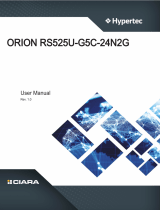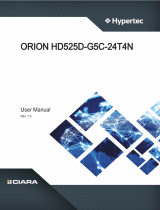
- 8 -
4-3-1 CBPH7O0 ...............................................................................................................45
Chapter 2 BIOS Setup ..................................................................................................47
2-1 The Main Menu .............................................................................................. 49
2-2 Advanced Menu ............................................................................................. 52
2-2-1 Trusted Computing .................................................................................................53
2-2-2 ACPI Settings .........................................................................................................54
2-2-3 APEI Conguration .................................................................................................55
2-2-4 General Watchdog Timer ........................................................................................56
2-2-5 X86 Emulation Conguration ..................................................................................57
2-2-6 PCI Subsystem Settings .........................................................................................58
2-2-7 Info Report Conguration .......................................................................................64
2-2-8 USB Conguration ..................................................................................................65
2-2-9 Network Stack Conguration ..................................................................................66
2-2-10 IP Conguration ......................................................................................................67
2-2-11 NVMe Conguration ...............................................................................................68
2-2-12 SATA Conguration.................................................................................................69
2-2-13 Graphic Output Conguration .................................................................................70
2-2-14 Power Restore Conguration .................................................................................71
2-2-15 Broadcom NetXtreme-E 2Px10GBASE-T OCP 3.0 Ethernet .................................72
2-2-16 MAC IPv4 Network Conguration ...........................................................................78
2-2-17 MAC IPv6 Network Conguration ...........................................................................79
2-2-18 Driver Health ...........................................................................................................80
2-3 Chipset Setup Menu ....................................................................................... 81
2-3-1 CPU Conguration ..................................................................................................82
2-3-2 RAS Conguration ..................................................................................................84
2-3-3 Memory Slot Information ........................................................................................85
2-3-4 Serialport console ...................................................................................................87
2-3-5 PCIE Root Complex Conguration .........................................................................88
2-4 Server Management Menu ............................................................................. 89
2-4-1 System Event Log ..................................................................................................90
2-4-2 Bmc self test log .....................................................................................................91
2-4-3 View FRU Information ............................................................................................92
2-4-4 BMC Network Conguration ...................................................................................93
2-5 Security Menu ................................................................................................ 94
2-5-1 Secure Boot ...........................................................................................................95
2-6 Boot Menu ...................................................................................................... 98
2-7 Save & Exit Menu ......................................................................................... 100
2-8 BIOS POST Beep code (AMI standard) ....................................................... 102
2-8-1 PEI Beep Codes ...................................................................................................102
2-8-2 DXE Beep Codes .................................................................................................102






















